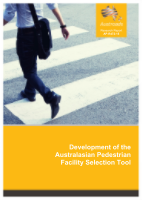Active Travel

- Publication no: AP-R472-15
- ISBN: 978-1-925037-31-9
- Published: 23 February 2015
- PDF (free) Download
This report documents the research undertaken to develop a standardised tool to help practitioners select the most appropriate pedestrian crossing facility for a particular site.
The project identified a number of gaps in existing walkability and pedestrian level of service research which lacks suitable models for assessing the relative benefits of different types of facilities for midblock and intersection crossings.
The analysis identified that the walkability of crossings could be evaluated by isolating the individual elements of perceived delay, perceived safety and comfort.
Community Street Review responses collected in a previous New Zealand research and the results of focus group surveys informed the development of additional walkability models.
The tool developed from the research assesses both midblock and intersection applications of raised platforms, kerb extensions, median refuges, zebra crossings, signals, grade separation and a combination of facilities.
The initial assessment considers which types of pedestrian crossing facilities are appropriate for the traffic environment. Feasible facilities can then be evaluated in relation to pedestrian and vehicle delay, safe sight distances, pedestrian level of service and economic evaluation.
- Summary
- 1. Introduction
- 1.1. Research Objective
- 1.2. Report Structure
- 2. Literature Review
- 2.1. Introduction
- 2.1.1. New Zealand and Australian Research/Behaviour Comparability
- 2.2. Walkability and Pedestrian Level of Service Evaluation
- 2.3. Pedestrian Facility Selection Guidelines and Evaluation Tools
- 2.3.1. NZ Transport Agency Pedestrian Facility Selection Guidelines and Spreadsheet
- 2.3.2. Queensland Pedestrian Crossing Facility Guidelines and Prioritisation System User Guide
- 2.3.3. Western Australia Guidelines for Assessing Pedestrian Level of Service
- 2.3.4. Pedestrian Environment Review System
- 2.3.5. Other Pedestrian Level of Service Guidelines
- 2.3.6. Selection Tool and Guidelines Discussion
- 2.4. Economic Analysis Guidelines
- 2.5. Legislation and Guidelines in New Zealand and Australia
- 2.5.1. Guidance Documents
- 2.5.2. Legislative Documents
- 2.5.3. Trialling Non-standard Facilities
- 2.6. Key Findings
- 3. Gap Analysis
- 3.1. Introduction
- 3.1.1. Existing Tools
- 3.2. Developing a Conceptual Framework
- 3.3. Identifying the Gaps
- 3.4. Addressing the Gaps
- 3.5. Summary of Gap Analysis
- 4. Analysis of Community Street Review Data
- 4.1. Introduction
- 4.2. Background
- 4.3. Model Development Methodology
- 4.3.1. Updating CSR Data
- 4.3.2. Predictor Variables
- 4.3.3. Testing of CSR Data
- 4.3.4. Analysis of CSR Variables to Perceived Characteristics
- 4.3.5. Analysis of Perceived Characteristics to Walkability
- 4.3.6. Direct Analysis of CSR Variables to Walkability
- 4.4. Discussion
- 4.4.1. Research Gaps Filled
- 4.4.2. Summary of Walkability Models
- 5. Walkability Focus Groups
- 5.1. Introduction
- 5.2. Focus Group Planning
- 5.2.1. Perceived Safety
- 5.2.2. Safety and Delay
- 5.2.3. Non-compliance
- 5.3. Focus Group Surveys
- 5.4. Focus Group Results and Analysis
- 5.4.1. Influence of Midblock and Intersection Locations
- 5.4.2. Understanding Compliance at Signals
- 5.4.3. Understanding the Perceived Safety of Crossings
- 5.4.4. Calculating the Perceived Safety Score
- 6. Selection Tool Method
- 6.1. Introduction
- 6.1.1. Applicability
- 6.1.2. Model Development
- 6.1.3. Limitations
- 6.2. Overview
- 6.2.1. Multi-part Crossings
- 6.3. Facility Feasibility Assessment
- 6.4. Facility Assessment
- 6.4.1. Delay Modelling
- 6.4.2. Safety Modelling
- 6.4.3. Sight Distance Calculation
- 6.4.4. Perceived Walkability Component Modelling
- 6.4.5. Economic Evaluation
- 6.4.6. Pedestrian Level of Service Modelling
- 7. Selection Tool
- 7.1. User Guide
- 7.2. Testing
- 8. Conclusions and Recommendations
- 8.1. Conclusions
- 8.2. Recommended Future Research
- References
- Appendix A Model Fit and Residual Plots for CSR Models
- A.1 Model Fit and Residual Plots for Perceived Characteristic Models
- A.2 Model Fit and Residual Plots for Perceived Characteristic Walkability Models
- Appendix B Focus Group Survey Form
- Midblock: Uncontrolled crossing
- Midblock: Zebra crossing
- Midblock: Signalised Crossing
- Intersection: Uncontrolled Crossing
- Intersection: Signalised Crossing
- Ranking of Crossings
- Delay vs Safety
- Signalised Crossings
- Comments:
- Scratch Sheet
- Appendix C Focus Group Flyer
- Appendix D Focus Group Workshop Structure
- D.1 Equipment
- Appendix E Technical Note: Zebra Crossings Crash Reduction Factor
- E.1 Technical Discussion
- E.2 Updated Source
- E.3 Proposed Actions
- E.4 Potential Issues
- E.5 References
